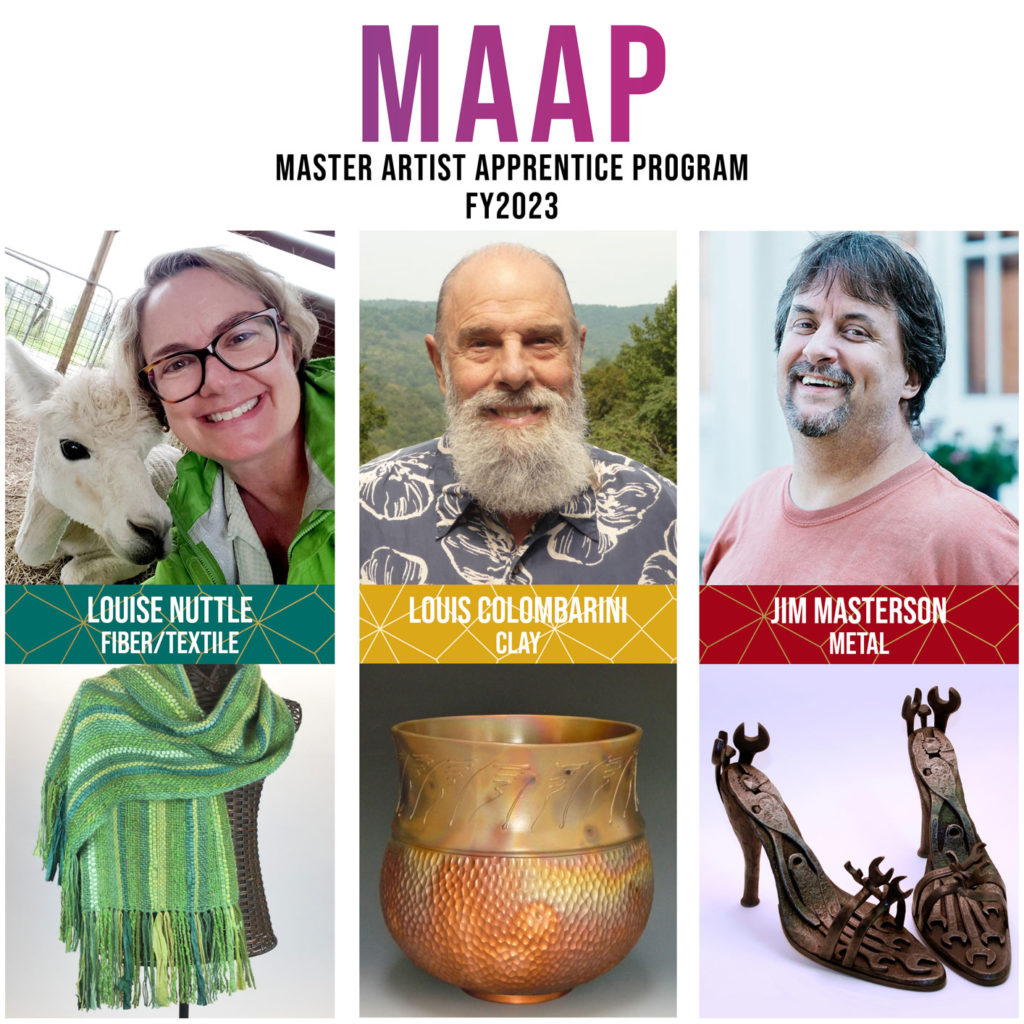Craft Master Artist Apprentice Program (MAAP) Virtual Exhibition
From Krishna Adams, Director of Visual Arts, Craft, Media, and Design –
Craft Master Artist Apprentice Program (MAAP) Virtual Exhibition
October 7, 2022–December 2, 2022
Master and Apprentice Online Artist Talk
Craft MAAP participants discuss their experiences in the program.
Check out our virtual exhibition’s beautiful artistic works resulting from the FY22 Craft Master Artist and Apprentice Program (MAAP)! The Master Artist Apprentice Program (MAAP) is a partnership between the Tennessee Arts Commission and Tennessee Craft. The mission of this collaboration is to encourage and invest in the continuation, advancement, and creation of craft in Tennessee by recognizing the role of the master craft artist and apprentice relationship to preserve the state’s cultural heritage. This partnership provides craft artists with relevant and alternative educational experiences. It promotes and facilitates fine craft as a viable career path for Tennessee artists through mentoring and the professional development of emerging craft artists.
This year, Tennessee craft masters shared their considerable skills and creative aptitude by providing one-on-one mentoring instruction with apprentice artists to encourage, strengthen and grow their artistic foundation. In its 13th year, the MAAP partnership continues cultivating the traditional master/apprentice relationship by awarding selected artists a grant to ensure craft art is nurtured in Tennessee.
The following partners worked together to sustain craft for the next generation:
Fiber/Textile: Jennifer Sargent, Master (Memphis, Shelby County) and M. Kelley, Apprentice (Nashville, Davidson County)
Clay: Jackie Schlicher, Master (Nashville, Davidson County) and Sarah Bollinger, Apprentice (Nashville, Davidson County)
Printmaking: Ashton Ludden, Master (Knoxville, Knox County) and Becca Martinez, Apprentice (Joelton, Davidson County)
Check out the exhibition here.
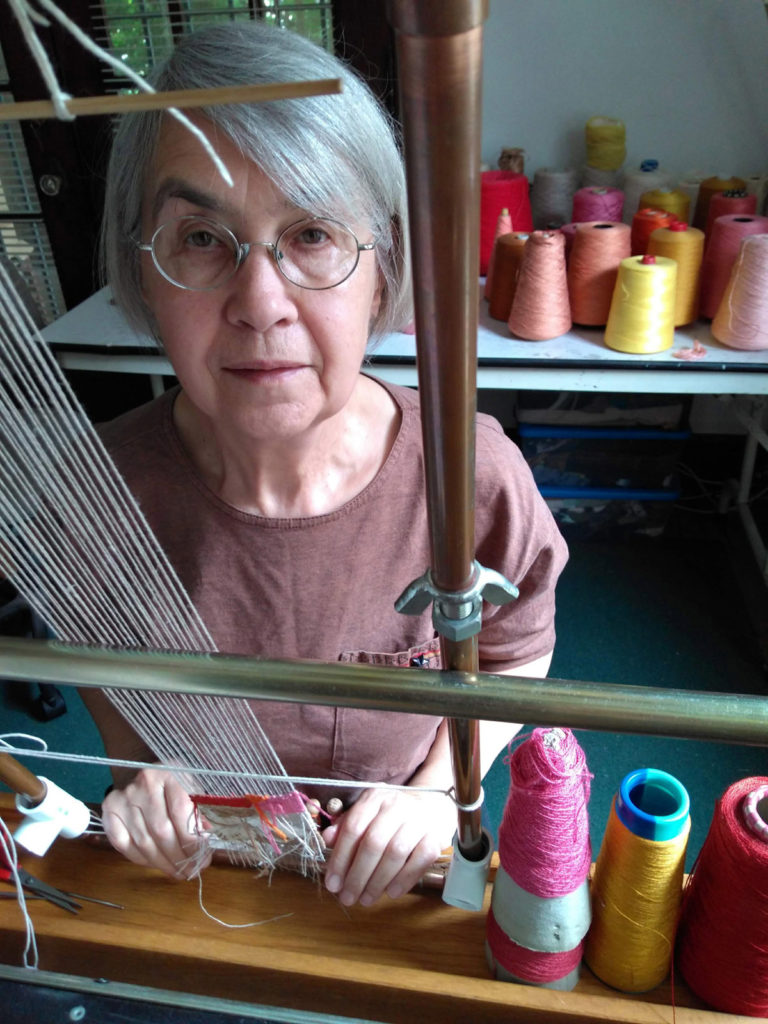
Master Jennifer Sargent (Memphis) has a B.A. in woven textiles from Middlesex University in London, England, and an M.F.A. in Fibers from Arizona State University in Tempe. She taught fibers at the University of North Texas and at Memphis College of Art for 12 years, where she was Director of Exhibitions for six of those years. Her art-making concentrates on woven tapestry and drawings. Some of her work is at the Tennessee State Museum, the City Collection of Memphis, Christian Brothers University, and the Wichita Center for the Arts. She is also an Individual Artist Fellowship recipient from the Tennessee Arts Commission. Learn more about Sargent’s work here.
“The world seems intent on eliminating personal, unmeasured time. Tapestry weaving, in contrast, is a slow process, allowing space and time to think. I love working and thinking with my hands: I draw, make woven samples, and weave scarves, and indispensable to all of this is an ongoing passion for texture and color. One of two elements is always present in my work, either story telling or the natural world (whether wild or domesticated). I then create a more abstracted sense of these ideas or experiences by layering pattern and color. As an artist weaver, I consider myself both a contemporary practitioner and a part of a longer continuum thousands of years old. This idea is both a comfort and a challenge as I continue to develop my work.” – Sargent
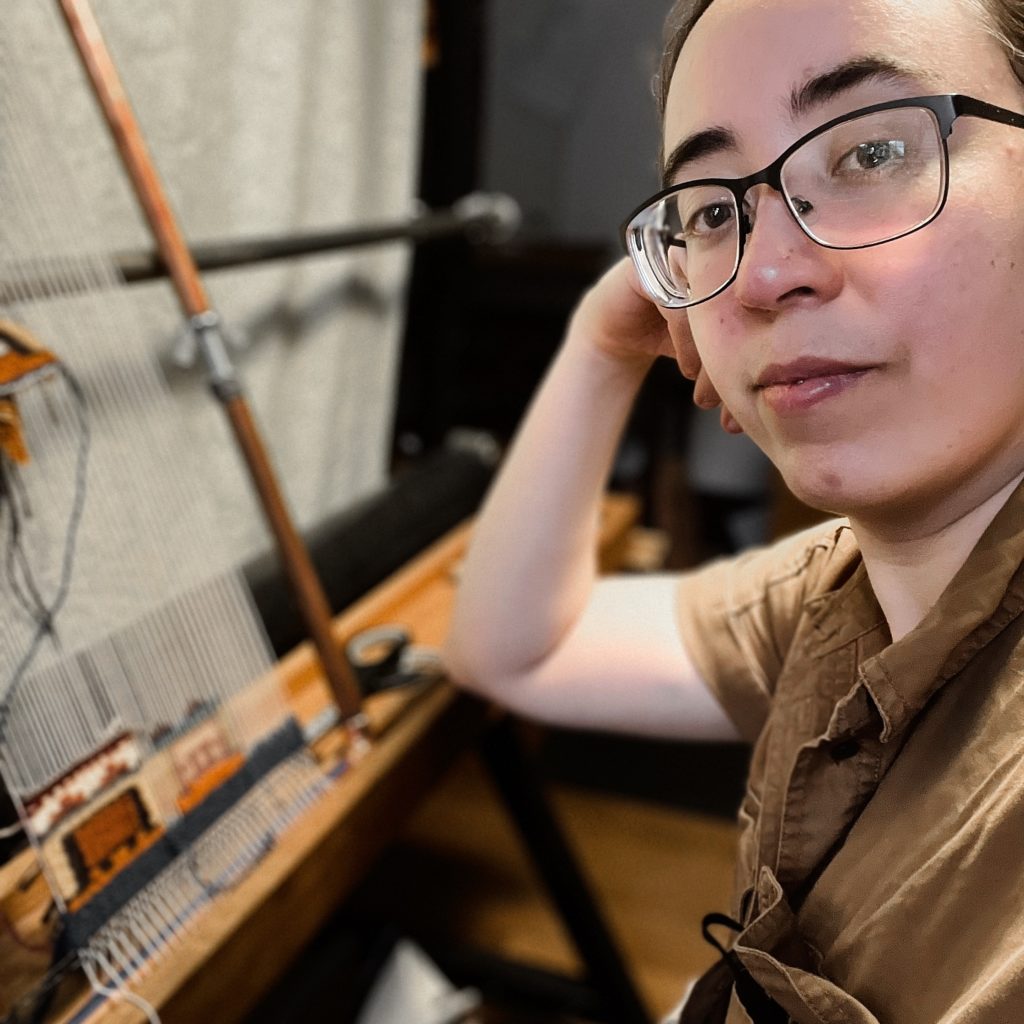
Tapestry Apprentice M. Kelley’s (Nashville) civic and social practice work focuses on sustainability for artists at all levels through creative placemaking, civic consulting, community development, advocacy, equitable access, and mentorship in the intersections of creativity, technology, and innovation. They are a graduate of The Learning Lab, the Racial Equity in Arts Leadership Institute, Vanderbilt’s Leading Innovation in Arts and Culture, and a Metro Nashville Committee for Antiracism and Racial Equity member.
When asked about the MAAP experience, Kelley responded, “My apprenticeship started with an intensive on weaving skills, as they applied specifically to the process of tapestry. It incorporated a technical study designed to walk through common methods used to create shape, plan form, and blend color through historical methods. From there, I worked on a piece that demonstrated these technical skills in relation to my own creative goals and existing process, incorporating handspun hand-dyed wool yarn to achieve the personal design. During this time, I also explored the process of making my tools with the makerspace equipment I had access to and looked at ways that tapestry serves the larger message and goals in my interdisciplinary practice. Finally, the apprenticeship led me to begin a body of work geared specifically towards merging all of these aspects. Working in this medium has dramatically informed and guided my weaving and spinning practice.”
Kelley has already expanded the mentorship process by passing along the techniques learned by Master Jennifer Sargent to new students, thus giving students a new range of techniques to hone and to pass on. Click here to find out more about Kelley’s work.
“In exploring tapestry, I pay respects to the terrain through the use of these sustainable cycles of cultivating color, and in the time-consuming labor of producing the tapestry object. Depicted in the MAAP series are places from my childhood – the Rio Bravo (or Rio Grande), the Coconino National Forest, and the Pinyon Plain Mine – whose natural spaces are threatened by political disagreement, climate change, and shortsighted human development.” – Kelley
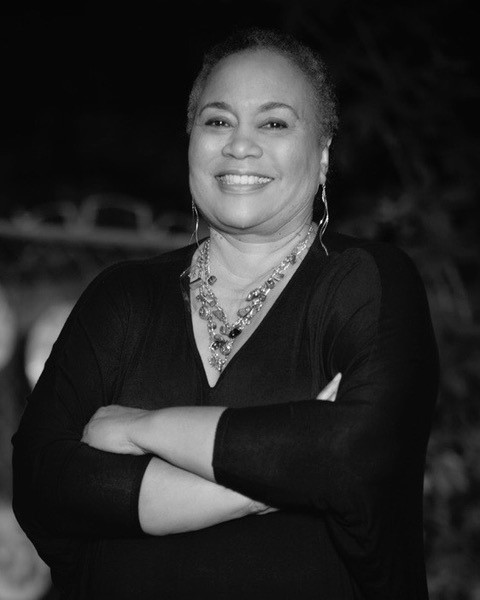
Eight years ago, Master Jackie Schlicher (Nashville) sat at a pottery wheel for the first time. Soon after, she set up her studio, Wildhair Pottery, and began her full-time exploration of the medium. Although traditional functional wares of cups, bowls, and plates, are standard forms she enjoys making, Schlicher has the most fun with the challenge of exploring less common wares such as clocks, French butter dishes, ocarinas, and coffee pour-over sets. Both light and dark brown stoneware clay are used, and most of her work is fired in an electric kiln at either cone five or six.
“Every creative life I’ve lived in this one life influences how I create my pots. And everything I’ve done creatively has influenced me. My singer’s life offers rhythm, tone, and harmony. My actor’s life expresses emotion and character. My director’s life offers perspective, guidance, and discovery. Making pots allows these creative aspects to appear as cups, bowls, plates, platters, and more. And in the making, I appear.” – Schlicher
For Schlicher , the functional clay pieces must be fun to make and a feast for the eyes. Her most recent passion is in a surface treatment called sgraffito, a technique that treats the surface of the clay as a canvas, allowing a variety of abstract and other visual designs to be expressed on the surface. In the piece, Like a Basket, the vase was decorated by painting white slip, then using the sgraffito technique, she carved through the white slip to reveal the dark brown stoneware underneath. She uses a variety of colored slips, carving, painting, and masking to create her surface designs. This process, combined with the exploration of new forms, allows her work to be an ongoing and satisfyingly creative challenge.
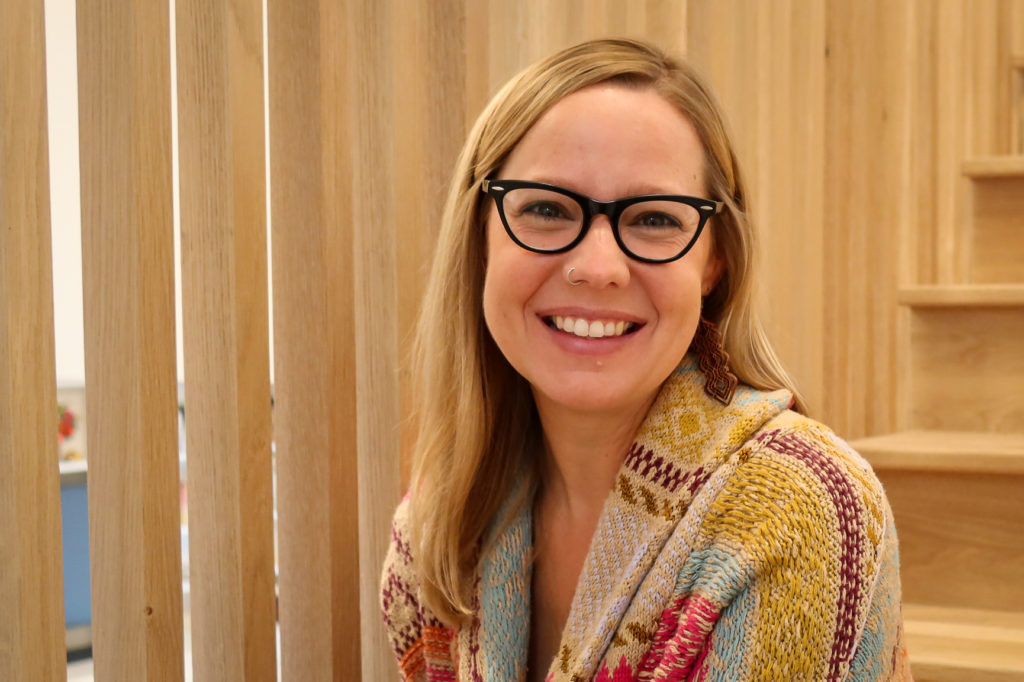
While in college, Clay Apprentice Sarah Bollinger (Nashville) fell in love with clay, learning the basics of throwing, glazing, and firing. After receiving a Masters in Social Work (M.S.W.) from New York University and a Doctorate in Social Work (Ph.D.) from Washington University in St. Louis, she became a Licensed Clinical Social Worker in Missouri and Tennessee. Years later, firmly established in the mental health field, Bollinger was gifted pottery classes from her partner, and her passion for ceramics was rekindled.
Bollinger’s wheel thrown matching dinnerware, rainbow glazed pitcher, and casserole dish explore the idea of connectedness. She explains, “As the world struggled to redefine relationships after the onset on COVID-19, we were all forced to reckon with big questions about belonging. Making these pieces brought to life the complexity and beauty of how things work together and exist in the same space.”
“This apprenticeship [with Master Jackie Schlicher] has been fundamental to my growth as a craft artist. These past six months have been instrumental in building my skill level, developing confidence, and growing my commitment to my art. This program’s skills, knowledge, and experience will impact me immensely. I had the time, resources, and guidance that I needed to lay a solid foundation under me, and I can only imagine growing in my craft from here on out. Pottery feels like an embedded part of my life in a way that it didn’t before. I identify as an artist and maker. I am making plans and setting goals for myself to continue growing in my work. This was a launching experience, and I’m excited to see where the path will lead!” – Bollinger
Bollinger also actively performs as a jazz musician, writing, singing, and playing piano. Find out more about Bollinger here.
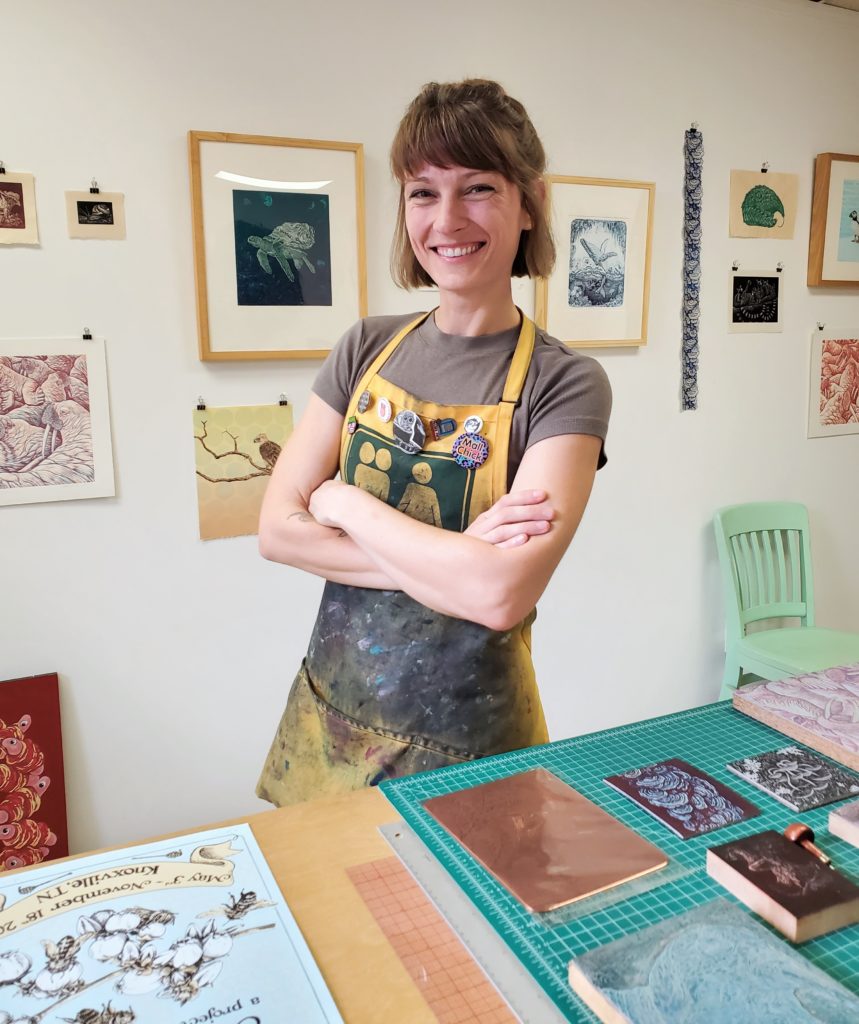
Master Ashton Ludden (Knoxville) is a printmaker, educator, and sign artist. She received a B.F.A. in Engraving Arts and Printmaking from Emporia State University in Emporia, Kansas, and an M.F.A. in Printmaking from the University of Tennessee in Knoxville. Ludden’s prints have been exhibited in galleries nationally and internationally. She actively teaches printmaking workshops across the United States. Ludden is the co-founder and artist of Relay Ridge Collaborative Artist Space and teaches printmaking at Knoxville’s Community School of the Arts. She is also the 2D Coordinator for the Spring Pentaculum Artist Residency at Arrowmont School of Arts & Crafts in Gatlinburg.
Ludden produces delicate, detailed prints of endangered animals and plant life, asking the viewer to consider the relationship between humans and wildlife as society becomes further removed from the natural world. She uses various printmaking methods when creating, such as hand-engraving on copper or wood, drypoint on plastic, chine collé, and monotype. The inked colors are loud and bright and are inspired by the packaging of consumer goods that end up in the landscape.
Co-existing with her fine art prints are explorations in found plastics, such as large wall weavings made from salvaged box straps. An example of this can be seen in the work Plastic Seize. The tangled, knotted net of plastics echoes its final form within polluted waters. Collectively, Ludden’s work considers the wild around us and is alert to our everyday actions that affect it. Her work aims to evoke a renewal of attentiveness and awareness of our direct and indirect impacts on the wild and to rejuvenate respect for other non-human beings. Visit Ludden’s website to see more of her work.
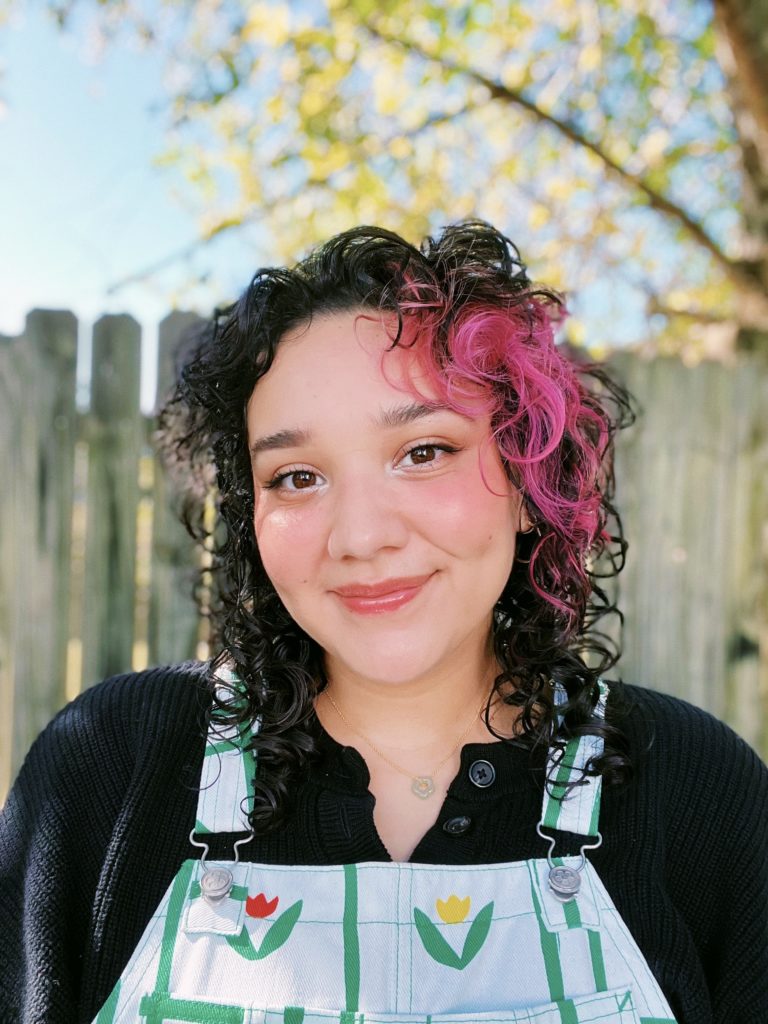
Print Apprentice Becca Martinez (Joelton) is an interdisciplinary textile/fiber artist and printmaker. She received a B.F.A. in Studio Art from the Department of Art + Design at Austin Peay State University in Clarksville. Her work has been exhibited in galleries and deals with themes of domestic space while having conversations about her own family, roots, and upbringing while growing up between cultures.
Her process incorporates embroidery and tufting on hand-dyed, drawn, and/or painted fabrics while integrating multiple traditional printmaking processes. Mexican folkloric and indigenous textiles and ceramics heavily influence her work through the style, vivid colors, and patterns she uses.
“I gained so much more knowledge and skills than I ever expected throughout my experience in the MAAP program, and I am very grateful to have had this opportunity. This experience has aided the growth of my practice as a professional artist tremendously. I learned learning directly from Master Aston Ludden in the print studio during hands-on demos/tutorials and had long conversations while brainstorming and sketching ideas out. I listened in on print classes she taught, and took trips to the art supply and hardware store. Listening/observing how Ludden’s collaborative studio is run and managed by her and her husband all aided in my learning. Having the privilege to be in this program has also made me bolder in applying for other programs and take more opportunities in the future.” – Martinez
Apply for the FY23 Craft Master Artist Apprentice Program (MAAP) by clicking the image below.
